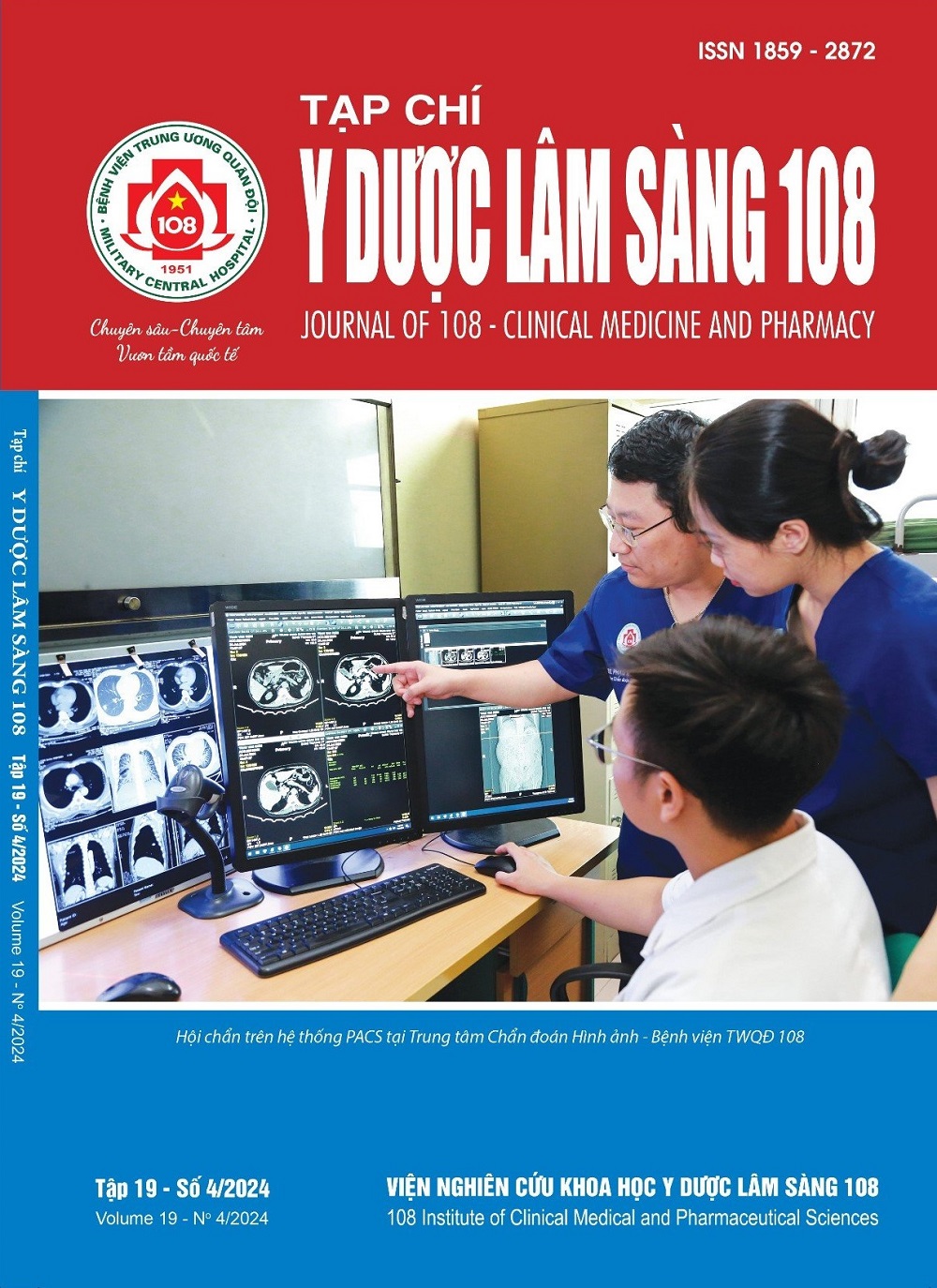Outcome of cholangioscopy-guided lithotripsy through T-tube tunnel by electrohydraulic for introhepatic stones at 108 Military Central Hospital
Main Article Content
Keywords
Abstract
Objective: To evaluate the results of treatment of residual bile duct stones in the liver using a soft endoscope through the Kehr tunnel for electrohydraulic lithotripsy. Subject and method: 76 patients were diagnosed with residual intrahepatic bile duct stones by ultrasound or magnetic resonance, and still had Kehr drainage. Endoscopically using a flexible endoscope for electrohydraulic lithotripsy through the Kehr tunnel at 108 Military Central Hospital from January 1, 2022 to January 1, 2024. Method: A cross-sectional, retrospective, prospective, non-controlled study. Result: 100% of patients had stones left in the liver and had a history of bile duct stone surgery. Female/male ratio=1.81. The rate of stones in the liver on both sides was the highest: 44.74%. Access to stones reached 97.5%. The stone-free rate was 88.16%, while the stone-free rate was 11.84%. Biliary stenosis accounted for 19.74%, mainly intrahepatic biliary stenosis. The average number of flirting times was 1.05 ± 0.22, at least 1 time, at most 2 times. The time for 1 lithotripsy through the Kehr tunnel was 61.02 ± 32.46 minutes, the shortest was 15 minutes, the longest was 160 minutes. Complications (1.32%) (Kehr tunnel rupture) were treated medically after 3 days of stable discharge from the hospital. Days of treatment after surgery: Average 1.77 ± 0.82 days, shortest was 01 day, longest was 04 days. Conclusion: Endoscopic soft tube through Kehr electrohydraulic lithotripsy is a safe and highly effective method in treating residual bile duct stones in the liver
Article Details
References
2. Nguyễn Quang Nam, Bùi Tuấn Anh, Lê Trung Hải (2020) Đánh giá kết quả nội soi tán sỏi qua đường hầm Kehr bằng điện thủy lực điều trị sót sỏi sau phẫu thuật nội soi sỏi đường mật mổ lại. Tạp chí Y - Dược học Quân sự số 9.
3. Bùi Tuấn Anh (2008) Nghiên cứu áp dụng kỹ thuật dẫn lưu mật xuyên gan qua da trong điều trị sỏi đường mật. Luận án Tiến sĩ y học, Học viện Quân y, Hà Nội.
4. Vũ Việt Đức, Lê Văn Thành, Trần Đức Quý (2020) Đánh giá kết quả điều trị sỏi đường mật trong gan bằng phẫu thuật nội soi và sử dụng ống mềm tán thủy lực qua ống nối mật da tại Bệnh viện Trung ương Quân đội 108. Tạp chí Y học Việt Nam tập 498.
5. Đặng Tâm, Lê Nguyên Khôi (2008) Đánh giá phương pháp lấy sỏi mật nội soi xuyên gan qua da. Tạp chí Y học TP. Hồ Chí Minh tập 12.
6. Đặng tâm (2004) Xác định vai trò của phương pháp tán sỏi mật qua da bằng điện thủy lực. Luận án Tiến sỹ Y học. Đại học Y Dược Thành phố Hồ Chí Minh.
7. Dương Xuân Lộc, Hoàng Trọng Nhật Phương, Hồ Văn Linh và cộng sự (2012) Hiệu quả tán sỏi điện thủy lực trong sỏi mật mổ lại. Tạp chí Gan mật Việt Nam, Tập 19, tr. 44-51.
8. Trần Vũ Đức, Lê Quan Anh Tuấn (2008) Kết quả sớm của nong đường mật qua nội soi đường hầm ống Kehr trong điều trị sỏi sót. Tạp chí Y học Thành phố Hồ Chí Minh, 12 (1), tr. 216-223.
9. Arya N, Nelles SE, Haber GB, Kim YI, Kortan PK (2004) Electrohydraulic lithotripsy in 111 patients: A safe and effective therapy for difficult bile duct stones. American Journal of Gastroenterology 99(12):2330-2334. doi: 10.1111/j.1572-0241.2004.40251.x.
10. Jeng KS (1992) Bile duct stents in the management of hepatolithiasis with long-segment intrahepatic biliary strictures. Br J Surg 79: 636-666.
 ISSN: 1859 - 2872
ISSN: 1859 - 2872
